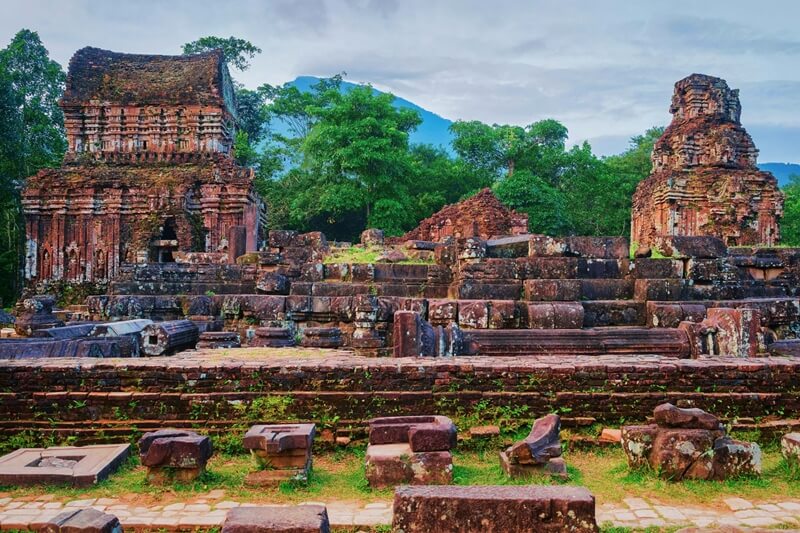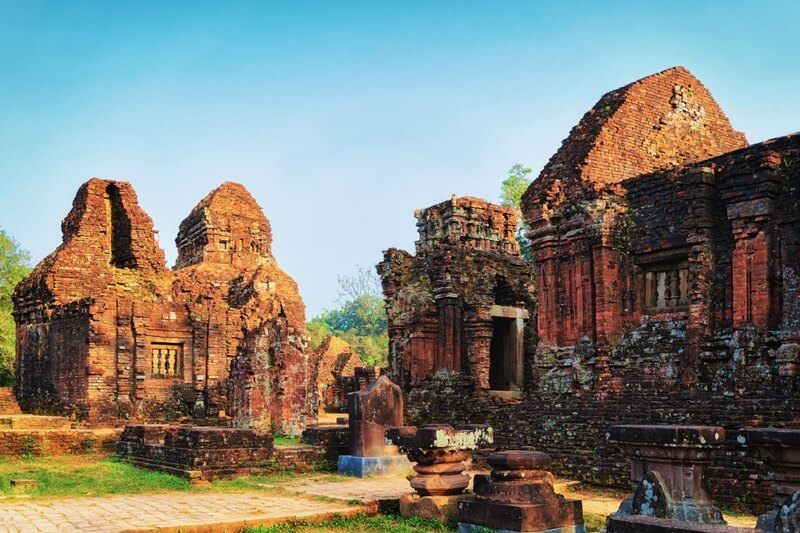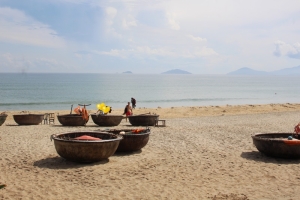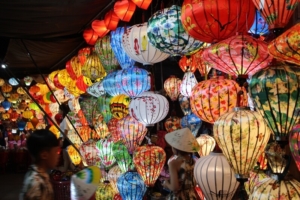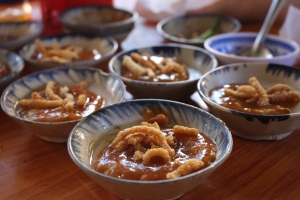My Son Sanctuary is located in a valley, 45 km from Hoi An Ancient Town and nearly 70 km from Da Nang City.
The holy land appears with an architectural complex of many Champa temples and towers. These old buildings built with clay bricks stay in a lovely valley, and most of them have aged from the 7th to 13th century.
Forgotten for a long time, My Son Sanctuary had not been discovered until 1885. UNESCO selected this place as a World Heritage site in 1999 as the vital proof of Asian civilization that has disappeared.
If you are a tourist who likes to explore and learn about ancient culture and architecture, this place is worth visiting.
My Son Sanctuary
My Son Sanctuary is a complex of ancient temples and towers in a 2km valley covered by high mountains, used to be the place to hold rituals as well as the mausoleum of the kings of the ancient Cham dynasty.
- Address: Duy Phu Commune, Du Xuyen District, Quang Nam Province, Vietnam
- Opening hours: 6:00 am – 5:00 pm, daily
- Phone number: +84 2353 731 309
- Entrance fee: 150,000 VND/ticket, including Jeep transfer from the ticket staff to the inside parking, visiting ancient temples, and Cham dance (if any).
- Dress code: Although we do not find dress code conditions to visit My Son sanctuary, you should wear elegant clothes to show respect because of the holy place: a shirt with sleeves, no two-wire coats, and paints covering your knees.
- My Son Sanctuary meaning: My Son has correct writing in Vietnamese: “Mỹ Sơn,” meaning the beautiful mountain, in which “Mỹ” means “beautiful,” and “Sơn” means “mountain”.
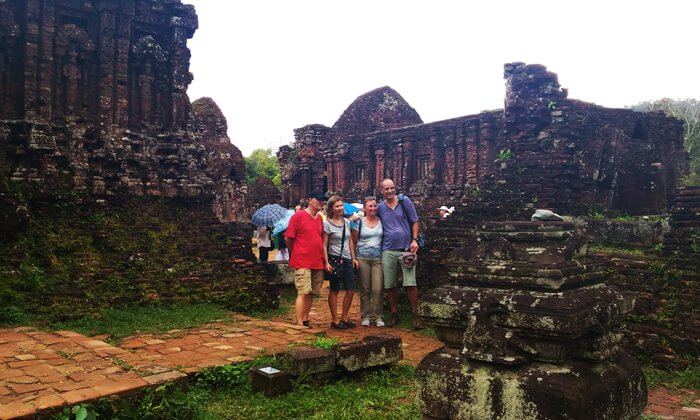
>> Please a private tour to visit My Son and Hoi An from Da Nang here!
Best time to visit My Son Sanctuary
Most guests come to visit the temples in My Son in the morning. So, you will see a lot of people there from 9:00 am – 12:00 pm.
In the late afternoon, after 3:00 pm, My Son has fewer guests, giving you a quiet time to take pictures of the ancient architectural buildings.
Typically, a few travel companies organize the sunrise tour in the early morning or sunset tour to help you escape from the crowd.
If you can get up early, a sunrise tour to explore the mysterious My Son Sanctuary from Hoi An at 5:30 am on dry days is worth doing.
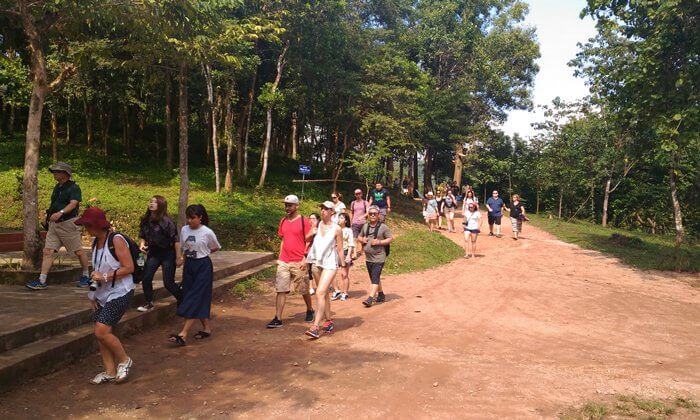
Travel from Hoi An to My Son
Traveling from Hoi An to My Son to discover the most mysterious Holy Land in Vietnam, you can move there by any motorbike, bus, or private car.
A private car
The popular route from Hoi An Old Town to My Son Sanctuary (following Highway 1A) is about 45km and takes 1 hour and 15 minutes to drive by car.
You follow Hung Vuong Street (Hoi An), turn left along National Highway 1A to run around 8 km until you see the Duy Xuyen Post Office on the right, and turn right into Hung Vuong Street (belonging to Duy Xuyen District).
Continue running around 18 km on Hung Vuong Street, and turn left onto DT 610 road to the My Son Sanctuary.
Motorbike
With the above route, you can travel by motorbike, the estimated time is also the same as using a private car 1 hour 15 minutes. You can find motorbike rentals from 200,000 VND/day at many shops or small hotels.
However, you need about 20 – 30 minutes more to go from the parking there to the main areas of the temples. This is because motorbikes have to park at the parking outside the gate to enter the route leading to the temple area.
Bus
If you think about using a bus, here is the information. There are no public buses from Hoi An to My Son Sanctuary. But you can use a tourist bus that serves plenty of backpackers. That means that you have to follow to touring time of the local agents.
So, booking a shared bus is not recommended for deluxe travel or family holidays. Meanwhile, a private car or van also offers an affordable price to get more convenient for your group.
Bicycle
If you want to do the tour to My Son from Hoi An by bicycle, you need to note the distance of 45 km/way. We recommend experiencing this transportation when you are a professional biker. For amateur cyclers, a bicycle tour around Hoi An countryside is enough to enjoy the cycling exercise.
What to see in My Son Sanctuary
Ancient temples and towers
My Son Sanctuary dates back to the fourth century when King Bhadresvara of Champa Kingdom built the first temple dedicated to King Bhadravarman, who was the founding king of the first Amaravati region at the end of the fourth century.
Many researchers found most temples from the 4th to 7th centuries were constructed with wood and almost destroyed. So, at present, the region in My Son Vietnam consists of ancient buildings from the 17th to 13th centuries.
The prominent highlight of the ancient Champa buildings is that brick frames remain intact, which shows the unique skills of using clay to build the temples.
My Son Holy Land has 70 buildings divided into 6 major groups, which are easier to visit and research: A, B, C, D, E, and G.
- Area A: This group is at the guardian temple. From here, you can observe areas C and D. The main temple of A has been restored, so you can see brighter bricks on its walls.
- Area B: This will be the west hill where one major temple and three auxiliary towers gather.
- Area E: The temples were almost destroyed, but this group gets the ancient color of time for beautiful photos.
- Area G: This group has just been restored and is located between groups B and E.
- Area C and D: This group stays in the southern valley and has become the most prominent area in My Son Sanctuary. You can find many inscriptions, temples, reliefs, and sculptures. In these groups is the main temple called Kalan. Its door faces the east, and a large Linga-Yoni used to be inside, but now only a stone Yoni pedestal is left.
Tip: You can explore this area in an opposite way, from C – D – B – G – E and A. Following this way, you can come to the theatre of Cham dance first.
Cham traditional performance
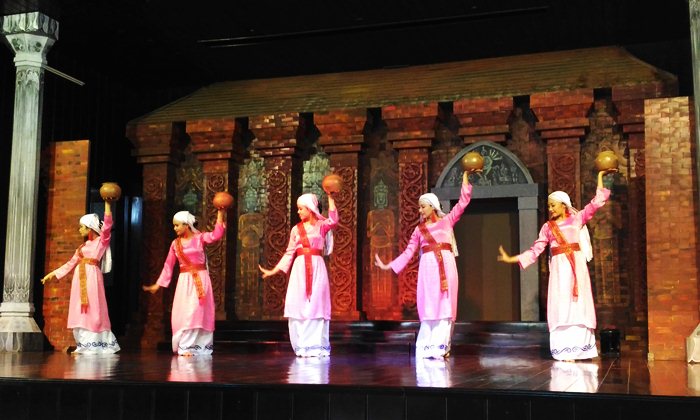
Cham dance is a recent activity in that tourists can see the traditional dance, drum, and flute at the small theatre in the area of My Son Temples.
Cham Dance opens three shows per day, 15 minutes long each. Although the performances are short, it is worth spending your time there.
Schedule of Cham traditional dance:
At the public stage:
- 1st show: 09:15 am
- 2nd show: 10:45 am
- 3rd show: 02:00 pm
- 4th show: 03:30 pm
(each show lasts 20 minutes)
At Group G:
- Morning show: 10:00 am
- Afternoon show: 02:45 pm
Shows in group G can be closed depending on the weather.
Tel to check: +84 235 731 309
Cham dance is gentle and unique, with the ritual series of steps towards the gods worshipped in the temples.
You will see the Cham girls who often wear candles, water, flowers, betel, and areca to celebrate, and look lively.
Also, the Apsara dance is an enchanting dance created from the statues of Apsara carvings on the temples and towers. The smooth and gentle beauty and the appealing curves that nature has bestowed on the dancers easily enchant the audiences.
The images of girls show curvy fingers, full breasts, and charming curves in sparkling costumes dancing to the sound of the Paranut drum and Sarai Nai flute.
The divine dance can make you get drunk and lost. In addition, the flute and other dances are also fanciable. All of them are waiting for your exploration.
The architecture of temples in My Son
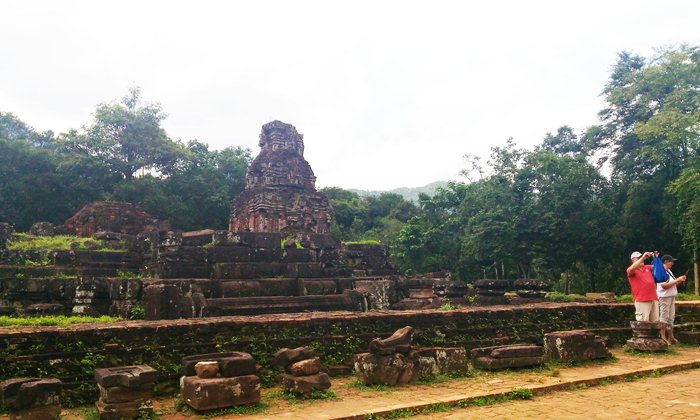
The relics of My Son carry lots of sculptural architectural styles typical for each historical period of the Champa kingdom.
Architectural styles here are divided into 6 categories: ancient style, Hoa Lai, Dong Duong, My Son, Po Nagar, and the style of Binh Dinh people.
In general, most of the architectural works and sculptures in My Son are influenced by Hinduism. The carving technique on the brick of the Cham people rarely appears in arts in other areas.
Most temples have pyramidal tops, the symbol of the holy Mount Meru, the residence of Hindu gods. And the gate of the old buildings usually turns to the east to receive sunlight.
The outside walls of temples are often decorated with S-shaped leaves. Besides, the decorations are sandstone sculptures of Makara (the mythical beast with sharp fangs and long hose), Apsara dancers, lions, elephants, Garuda birds, and the statures of prayers.
All the motifs and statues are skillfully stuck together and with the walls. And up to now, no research work can determine and create the adhesive perfectly and the way to connect these details.
The highlight of the Cham sculpture art is to show the intense vitality of the people with the multiple emotions inside, at the moment of joyful feelings, at times of both calmness and anxiety.
From the 7th to 13th centuries, each historical period has its own mark with a distinct architectural style, which you can find on the external decorations and materials on the ancient buildings in My Son temples.
In general, My Son Sanctuary shows not only the remarkable masterpiece of Champa architecture but also the culture of Southeast Asia.
Frequently asked questions about My Son Sanctuary
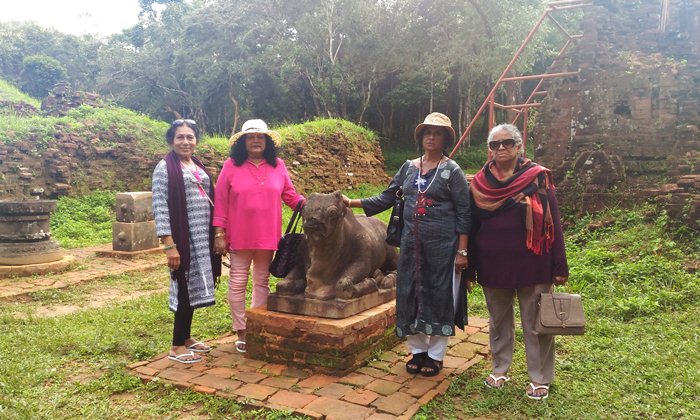
Can I pray in My Son Sanctuary?
No, you cannot. Although this site owns the famous ancient temples, it does not support activities such as worshiping or praying everywhere here, just for visiting.
How long can I visit My Son Sanctuary from Hoi An?
Exploring My Son Holy Land from Hoi An Ancient Town takes 4 to 5 hours. You need to spend 1 hour to 2 hours to discover most of My Son temples.
What was the purpose of building the temples in My Son?
My Son in Vietnam was the Hindu mecca of the Kingdom of Champa. Each king right ascending the throne came to this Holy Land to do a baptism ceremony, gave offerings, and built temples.
Besides the function of rituals that helped the kings to approach the gods, My Son Sanctuary became the cultural and religious center of the Champa dynasties and the burial place of kings and high-ranked monks.
Who discovered My Son Sanctuary after many centuries lost?
In 1885, My Son relic was discovered by a group of French soldiers.
In 1898 – 1899, two researchers from France, L.Finot and L.de Lajonquière, and another architect and archaeologist H. Parmentier went to My Son to study the epitaph and art of architecture and sculpture of the Cham people.
But, until the year 1903 – 1904, L.Finot officially announced the basic documents about the inscription and the architectural art of My Son.
How long had My Son Sanctuary developed?
My Son Sanctuary is the only place of Cham art with continuous development from the 7th to the 13th century.
In the early 7th century, King Sambhuvarman built the temple with very stable materials, which still exists today. The later kings were remodeling the old temples and building new temples to offer them to their gods.
Which was the major worshipping object in My Son Sanctuary?
The main temples in My Son Sanctuary worshipped a couple of Linga and Yony which is an image of Siva – the protector of the Champa kings.
The prominent god worshiped in My Son is Bhadrésvara, who founded the first kingdom of the Amaravati region in the late 4th century, in association with the Shiva god, becoming the god-king.
Conclusion
My Son Sanctuary preserves ancient vestiges of culture and contains unique historical, architectural, and artistic values.
Time and wars have devastated these monuments. But what remains here is still the mystical beauty. The typical architecture of the Champa people has attracted the curiosity of domestic and foreign tourists.
Although Vietnamdrive tries to give you the most updated information about My Son Sanctuary, lots of mysterious attractions live there and wait for your exploration.
